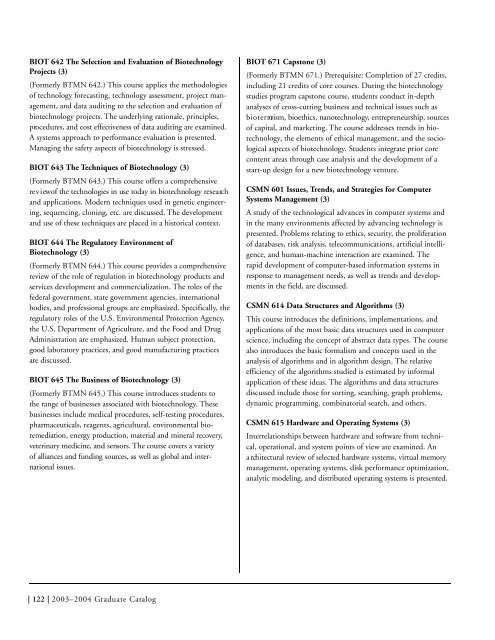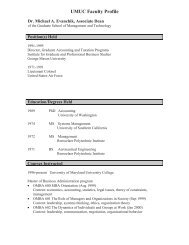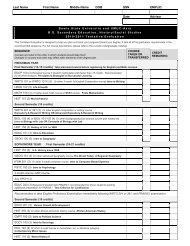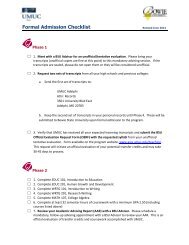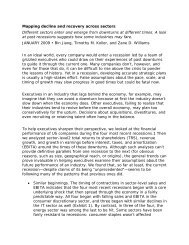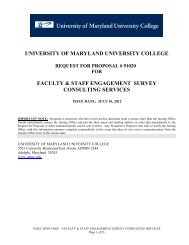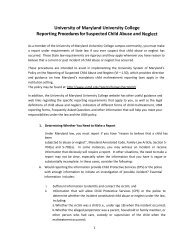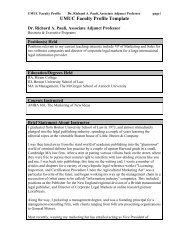A+B. Intro_SJ.1 - University of Maryland University College
A+B. Intro_SJ.1 - University of Maryland University College
A+B. Intro_SJ.1 - University of Maryland University College
Create successful ePaper yourself
Turn your PDF publications into a flip-book with our unique Google optimized e-Paper software.
BIOT 642 The Selection and Evaluation <strong>of</strong> Biotechnology<br />
Projects (3)<br />
(Formerly BTMN 642.) This course applies the methodologies<br />
<strong>of</strong> technology forecasting, technology assessment, project management,<br />
and data auditing to the selection and evaluation <strong>of</strong><br />
biotechnology projects. The underlying rationale, principles,<br />
p ro c e d u res, and cost effectiveness <strong>of</strong> data auditing are examined.<br />
A systems approach to performance evaluation is presented.<br />
Managing the safety aspects <strong>of</strong> biotechnology is stressed.<br />
BIOT 643 The Techniques <strong>of</strong> Biotechnology (3)<br />
(Formerly BTMN 643.) This course <strong>of</strong>fers a comprehensive<br />
re v i ew <strong>of</strong> the technologies in use today in biotechnology re s e a rc h<br />
and applications. Modern techniques used in genetic engineering,<br />
sequencing, cloning, etc. are discussed. The development<br />
and use <strong>of</strong> these techniques are placed in a historical context.<br />
BIOT 644 The Regulatory Environment <strong>of</strong><br />
Biotechnology (3)<br />
(Formerly BTMN 644.) This course provides a comprehensive<br />
review <strong>of</strong> the role <strong>of</strong> regulation in biotechnology products and<br />
services development and commercialization. The roles <strong>of</strong> the<br />
federal government, state government agencies, international<br />
bodies, and pr<strong>of</strong>essional groups are emphasized. Specifically, the<br />
regulatory roles <strong>of</strong> the U.S. Environmental Protection Agency,<br />
the U.S. Department <strong>of</strong> Agriculture, and the Food and Drug<br />
Administration are emphasized. Human subject protection,<br />
good laboratory practices, and good manufacturing practices<br />
are discussed.<br />
BIOT 645 The Business <strong>of</strong> Biotechnology (3)<br />
(Formerly BTMN 645.) This course introduces students to<br />
the range <strong>of</strong> businesses associated with biotechnology. These<br />
businesses include medical procedures, self-testing procedures,<br />
pharmaceuticals, reagents, agricultural, environmental bioremediation,<br />
energy production, material and mineral re c ove ry,<br />
ve t e r i n a ry medicine, and sensors. The course covers a variety<br />
<strong>of</strong> alliances and funding sources, as well as global and international<br />
issues.<br />
BIOT 671 Capstone (3)<br />
(Formerly BTMN 671.) Prerequisite: Completion <strong>of</strong> 27 credits,<br />
including 21 credits <strong>of</strong> core courses. During the biotechnology<br />
studies program capstone course, students conduct in-depth<br />
analyses <strong>of</strong> cross-cutting business and technical issues such as<br />
b i o t e r rorism, bioethics, nanotechnology, entre p re n e u r s h i p, sourc e s<br />
<strong>of</strong> capital, and marketing. The course addresses trends in biotechnology,<br />
the elements <strong>of</strong> ethical management, and the sociological<br />
aspects <strong>of</strong> biotechnology. Students integrate prior core<br />
content areas through case analysis and the development <strong>of</strong> a<br />
start-up design for a new biotechnology venture.<br />
CSMN 601 Issues, Trends, and Strategies for Computer<br />
Systems Management (3)<br />
A study <strong>of</strong> the technological advances in computer systems and<br />
in the many environments affected by advancing technology is<br />
presented. Problems relating to ethics, security, the proliferation<br />
<strong>of</strong> databases, risk analysis, telecommunications, artificial intelligence,<br />
and human-machine interaction are examined. The<br />
rapid development <strong>of</strong> computer-based information systems in<br />
response to management needs, as well as trends and developments<br />
in the field, are discussed.<br />
CSMN 614 Data Structures and Algorithms (3)<br />
This course introduces the definitions, implementations, and<br />
applications <strong>of</strong> the most basic data structures used in computer<br />
science, including the concept <strong>of</strong> abstract data types. The course<br />
also introduces the basic formalism and concepts used in the<br />
analysis <strong>of</strong> algorithms and in algorithm design. The relative<br />
efficiency <strong>of</strong> the algorithms studied is estimated by informal<br />
application <strong>of</strong> these ideas. The algorithms and data structures<br />
discussed include those for sorting, searching, graph problems,<br />
dynamic programming, combinatorial search, and others.<br />
CSMN 615 Hardware and Operating Systems (3)<br />
Interrelationships between hardware and s<strong>of</strong>tware from technical,<br />
operational, and system points <strong>of</strong> view are examined. An<br />
a rchitectural re v i ew <strong>of</strong> selected hard w a re systems, virtual memory<br />
management, operating systems, disk performance optimization,<br />
analytic modeling, and distributed operating systems is presented.<br />
| 122 | 2003–2004 Graduate Catalog


